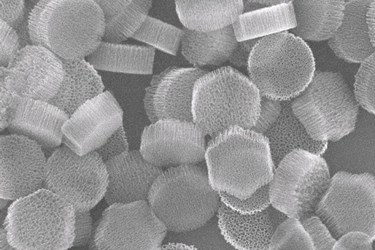Magnetically Guided Nanoconstructs Could Improve MRI, Cancer Treatment
By Joel Lindsey

Researchers at Rice University and The Methodist Hospital Research Institute (TMHRI) in Houston have created new nanoscale structures that contain iron oxide particles. Injected into the body and guided by magnetic fields to target sites, these “nanonconstructs” could be used to enhance magnetic resonance imaging (MRI), attack malignant tissue, and deliver drugs.
“Iron oxide nanoparticles are formidable multifunctional systems capable of contrast enhancement in magnetic resonance imaging, guidance under remote fields, heat generation, and biodegradation,” researchers involved with the project wrote in a paper published in the journal Advanced Functional Materials. “Yet, this potential is underutilized in that each function manifests at different nanoparticle sizes.”
In order to overcome this obstacle, and to more effectively make use of iron oxide’s capabilities, scientists packaged thousands of iron oxide particles inside larger silicon mesoporous particles (SiMPs) and discoidal polymeric nanoconstructs (DPNs).
Once combined, the iron oxide present in the nanostructures made it possible for researchers to remotely control the particles’ movements using magnets.
“They get attracted by the magnet, and that induces another dipole-dipole magnetic interaction among the particles and increases their interparticle communication mechanism,” Ayrat Gizzatov, a Rice researcher involved with the project, said in a press release.
The ability to accurately and precisely control the movement of the nanostructures, along with the presence of iron oxide, could make these nanostructures effective in a variety of medical applications. They could be used to enhance the contrast in MRI, potentially making this imaging technique more effective in diagnosing diseases. Using the heat that iron oxide can generate when triggered in particular ways, the nanostructures could be used to destroy dangerous tissues. They could also be used to carry payloads of drugs directly to specific target sites. After being used, the nanostructures would then safely biodegrade back into the body.
Magnets are an emerging method for controlling the movements of tiny devices and particles inside the human body. In addition to the Rice iron oxide project, researchers at universities in Egypt and the Netherlands recently devised a tiny micro-robot that responds to fluctuations in a magnetic field in order to move throughout a patient’s body.
According to an article published by Med Device Online, these tiny robots, like the nanostructures created by Rice researchers, could be navigated to precise locations in order to deliver drugs, clean clogged arteries, or to perform a number of other possible medical related functions.
Image credit: Wilson Group/Rice University
